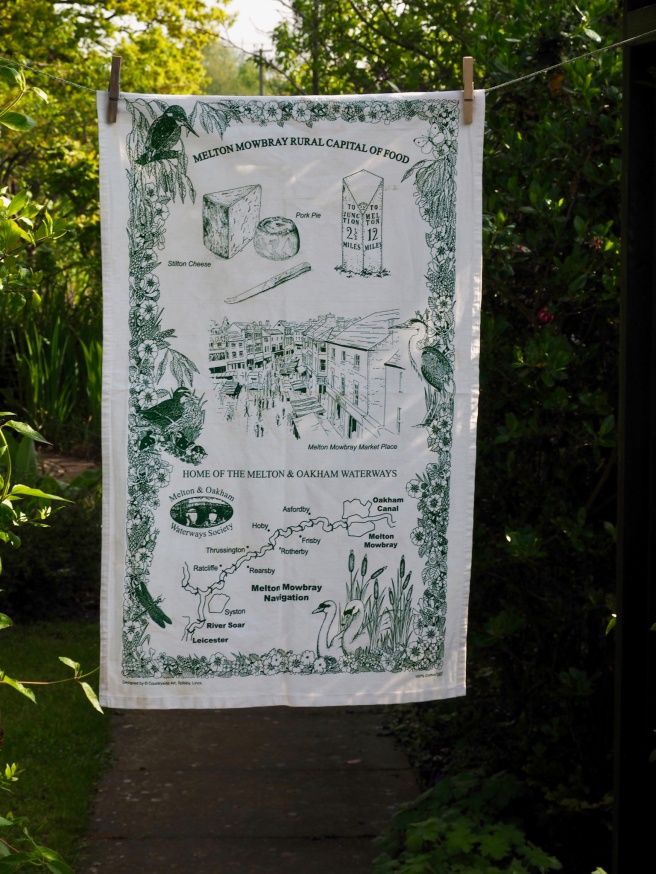
I bought this tea towel in 2007 because I was there and knew I didn’t have one from Melton Mowbray. My association with Melton Mowbray goes way back before that date. I remember spending quite a lot of my working time in Melton Mowbray in 1991 because I was involved, from an advocacy point of view, in a review of day services for people with physical impairments in Leicestershire; this was well before there was local government reorganisation and Leicester/Leicestershire split. There was an interesting day centre in Melton Mowbray called Norman Way Day Centre, set in a very old building with a customer group that were really committed to attending, and for the centre to remain open. Unanimously, they decided they wanted to keep it open and Leicestershire County Council didn’t challenge that decision at that time (although later on, they overrode the wishes of the people who attended). I met a lot of interesting people there for whom the centre was an important part of ensuring that they were not socially isolated. Having a hot meal and meeting friends was an essential part of enabling people to live at home; this was a lesson that I held onto throughout the rest of my working life.
‘Melton’ means ‘middle town surrounded by small hamlets’ and ‘Mowbray’ is a Norman family name; these two facts reflect how Melton Mowbray has developed since Roman times. Melton Mowbray has held a market on a Tuesday since 1324 by Royal Warrant; it is the third oldest market in England. It was at the Melton Mowbray market that John, my late husband, bought his chickens for the garden in Thurmaston in 1993 (and about which the neighbours put in a complaint concerning the noise they made and he had to get rid of them). There were no chickens kept in the area at that time; certainly things have changed over the last twenty years and it is much more common to keep chickens in gardens now.
Melton Mowbray is an interesting place with more history than most people would expect. It is near the Fosse Way (the old Roman road) and there are a lot of Roman antiquities nearby; the Melton Carnegie Museum tells the story of Melton Mowbray’s history with artefacts like shrapnel from the Second World War and the history of fox-hunting in the area. In 1837, the fox-hunting crowd of the Marquis of Waterford were riding through Market Street and found some tins of red paint which they liberally daubed all over the buildings; the remnants can still be found on some of the older buildings. People have always wondered whether this incident was the origin of the expression ‘Painting the town red’; others dispute this and suggest that it originated in America (but it would seem to be a literal meaning of the expression). There was an RAF base just outside of Melton Mowbray which was used for Displaced Persons by the Polish Resettlement Corp; this accounts for why Melton Mowbray has quite a big population with Polish origins. Melton Mowbray is today promoted as the ‘Rural Capital of Food’; this does not refer to the fact that Pedigree Petfoods (with all its former names) has been based there since 1951, producing over 4 million items of petfoods a day. It does, however, refer to the fact that Melton Mowbray is the home of the Melton Mowbray Pork Pie and Stilton Cheese, both of which have been granted Protected Designation of Origin (PDO) status by the European Union. The Pork Pie was designated in 2008 for pork pies made in and around the designated area of Melton Mowbray. Stilton Cheese is more complicated. It was designated in 1996 for blue-veined cheese, made with pasteurised milk in a cylindrical shape with a crust; it has to be made in Deryshire, Nottinghamshire or Leicestershire, which doesn’t include the village of Stilton (which is in Huntingdonshire). Stilton was never made in Stilton but it was the first place that it was sold. Stilton Cheese can claim fame that it has a sonnet written about it, by GK Chesterton, and in 2005 the British Cheese Board did give a warning that eating Stilton Cheese late at night can cause disturbed dreams.
Christmas was never Christmas without a full Melton Mowbray Pork Pie sitting on the Boxing Day table and a Stilton Cheese with port. Since that time I have always loved pork pie and eating it does bring back memories of the heavily laden table at Boxing Day. However, I am not so keen on this tea towel because I believe it doesn’t know what it’s theme is. The top half of it is about Melton Mowbray being the Rural Capital of Food and the lower half is ‘the Home of Melton and Oakham Waterways’. Is it trying to be two tea towels in one cloth? If so, it doesn’t work. It makes it a crowded image. I like both Pork Pies and Stilton Cheese but this isn’t my favourite tea towel on the grounds of design. One last question: does this ‘Blob’ win awards for one of the most boring I have written? I think it probably does but readers please do not answer this question!!
Click below to return to the Virtual Tea Towel Museum
